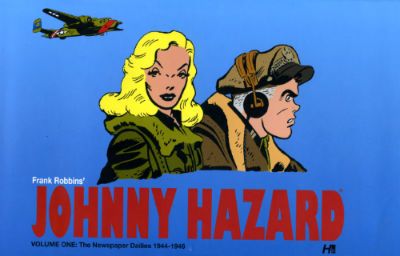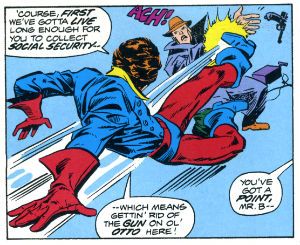"Oh, Jumping Joe!" COMICS! Sometimes They Appeared Daily In Newspapers While The World Burned!
/Hello again! What could be more alluring than a look at some old timey newspaper strips from the days when World War Two was still in full swing, strips by a man who has been dead since 1994! I shall capture that Youth Market, yet. Anyway, this...

FRANK ROBBINS' JOHNNY HAZARD VOLUME ONE: The Newspaper Dailies 1944-1946 By Frank Robbins Introduction by Daniel Herman Hermes Press, $49.99 (2011) Johnny Hazard created by Frank Robbins
When it comes to comics posterity can be a bit of an ass. Case in point: Mr. Frank Robbins esq. (1917 – 1994). Now, Frank Robbins was an artist, sorry, an Artist. And this might be difficult to believe if you think of the things we usually think of when we think of Frank Robbins. Because what do we think about when we think about Frank Robbins? Some of us might think of his work on DC’s The Shadow or maybe the fact that he is credited as starting Batman comics on the long, dark road to gritdom, but mostly let’s face it, effendi, most of us remember him for The Invaders and stuff like this:
Which is where I, in a younger incarnation, first saw Frank Robbins’ art and fell for it hard. No, not so much the issues where Vince Colleta’s horrific inking dehydrated Robbins’ art to the point of dusty incoherence, rather the issues where Frank Springer put the, er, spring back in Frank’s step with lovely slabs of black and a wholly sympathetic feel for the effects Frank Robbins was after. And the effect he was after was “aliveness”. Robbins’ art was primarily concerned with imbuing a sense of life within his static images. And on the pages of Johnny Hazard the reader gets to see Frank Robbins achieve this effect in every panel. Because on the pages of Johnny Hazard Frank Robbins is flying solo. Uncompromised by the penciller/inker division of The Big Two the reader is allowed to appreciate Robbins’ art fully.
The sense of life is most apparent in Robbins’ humans. Very few of his figures stand stock still as though they have a stick holding them up, instead they are usually portrayed in a way which seeks to fix their existence in that particular moment caught in his particular panel, and to further imply that before that panel and after that panel they will continue existing even if we never see them again. Arms are folded, shoulders cocked, hands gesticulate, faces crinkle and open appropriately and that’s just when they are at rest. When in motion Robbins’ figures really move. But Robbins’ genius here is in his ability to convey the sense of life via the inanimate objects. Everything from the clothes characters sport to the environment around them and the machines which seek to destroy both contain bold yet elegant cues to their texture. With a style as heavy as Frank Robbins’ style these anchors to reality enable even the most casual of readers to enjoy the content.
And the most casual of comics readers did enjoy Johnny Hazard. Robbins began the strip in 1944 and it folded in 1977, a hardly negligible run. The strips in this book cover 1944 – 1946 and so Johnny Hazard is firmly set in World War 2. It isn’t a war strip though, it is an action/adventure strip set in war time. Nonetheless Robbins’ does on occasion briefly acknowledge the horrors of his setting with the death of a mother, the exhaustion of the pilots and the reactions of survivors to losses incurred. Mostly though Johnny Hazard is entertainment set in war time. This may be a tough sell for some but the war was still underway for the majority of the time Robbins produced these strips and it’s not usual for the Home Front to desire a conflict’s complexities and true horrors to be presented while they are still up to their necks in it. I thought the material did a decent job of being entertaining without ever slipping into gung-ho jingoism. The war in Johnny Hazard is a hard war and while the essentially screwball nature of Johnny’s antics might distract from this it is still apparent.
But the war was a long time ago and so were these comics and much has changed in the meantime. Consequently old comic strips have the added burden of being read by potentially revisionist eyes. Racism, we’re heading into racist territory here. Great. And I’d say Johnny Hazard comes off pretty well. Which is more than the Japanese Armed Forces does, but then, and it really is very important to note this, they were the enemy at that particular point in time. And still, and still, despite the garbled syntax, period appropriate slurs and occasional buffoonery on display Robbins’ is really just emphasising the villainous nature of Johnny’s opponents in a typically melodramatic style suited to his genre. Individuals are singled out for this treatment so as to allow the audience to boo and hiss but the wider context of the strip still conveys a sense that the Japanese are a formidable enemy. Any Chinese characters encountered are resourceful and brave indicating that it isn’t not being Caucasian that’s the problem; rather it’s being the enemy. Although the Chinese do have that silly syntax too. Mind you so do one of the Yanks and a French lady. I guess Frank Robbins hated everyone! No, I don’t know, racism? There’s a bit. You're young and strong, you'll cope.
And what of the ladies how do the ladies fare in Johnny Hazard? The ladies fare surprisingly well in Johnny Hazard. They are all capable, feisty, determined and other such characteristics which are generally positive. Woman wise here Robbins’ art seems erotically imprinted by fever dreams of Veronica Lake and is less heated and torrid than it would later become when Joan Crawford apparently became Robbins’ epitome of eroticism. Sure, there’s a woman who uses her feminine wiles but then again there’s another woman who is a hard as nails resistance fighter who could care less about romance. One stops tanks by flashing her gams while the other gets the most startling scene of violence in the book; upending a bowl of hot coals onto the head of her nemesis and just flat staring down at him as he dies screaming. Yeah I reckon Frank Robbins has plenty of range when it comes to the ladies.
The stories are okay, too. They are though adventure serial yarns with a sense of humour some might see as verging on the cornball. One pivotal plot point revolves around someone’s name being phonetically similar to the word “marijuana”. Which is okay by me. Still, for every pilot who thinks he’s in the navy and speaks and acts accordingly to not entirely hilarious effect there’s a masterpiece of visual comic staging like this:
Which is apt because on every page of this book the visuals trump everything. The real appeal of this book is the art by Frank Robbins. All else is just a vehicle for the delivery of Robbins’ art. Which is appropriate because Frank Robbins was an artist. Sorry, an Artist. This is made clear in the sparse but dense blurb adorning the book about the man himself. This tells us that amongst other achievements at the age of nine Frank Robbins was awarded a scholarship to the Boston Museum of Fine Arts, he later illustrated for Life and The Saturday Evening Post and his paintings were exhibited at The Metropolitan Museum of Art amongst other such tony venues. So, it would be a bit of a shame if we remembered Frank Robbins primarily for this:
Frank Robbins' Johnny Hazard Volume One: 1944 – 1946 is not only cumbersomely titled but is also pure Frank Robbins and is thus a much better way to remember him. Although I bet the ‘70s volumes when his Sweat’n’Shadows style was at its apex are well worth waiting for. And wait I shall. In the meantime Johnny Hazard, despite the meat’n’taters nature of the packaging and maybe a smidgen of racism, is VERY GOOD!
Who knew Newspapers don't just contain fish'n'chips, sometimes they contain - COMICS!!!

















